#Maybe Steam achievements also help replayability
Explore tagged Tumblr posts
Text
I rly liked Minami Lane but I didn't expect the missions to be so few. I guess sandbox mode makes up for it but they almost felt more like tutorial levels for sandbox mode except the game didn't push me toward sandbox mode when I finished - just the credits
#Txt#Haven't tried sandbox yet but i hope i vibe with it#I think I will just.. slightly jarring user experience#3 hours of guided playtime for $5 is just... disappointing but it depends on sandbox#Again I just! Don't feel like they're rly guiding me toward sandbox which makes me wonder#how enjoyable that one is ig#And random(?) variables make missions sorta repayable maybe#Clearly lots of love and care went into this game I'm just glad I got it on sale lol#Maybe Steam achievements also help replayability#Just so surprised at the reviews being overwhelmingly positive tm#since I did think the game was just done after credits and imagine others felt#slighted from that misunderstanding as well#I wonder if it used to be cheaper
0 notes
Text
🥩My Sweet! Housemate Official Announcement🥩

As promised, I am now revealing a small project I and ghost-realms have collaborated on.
youtube





My Sweet! Housemate is an interactive visual novel style game that puts you into the shoes of a homeless adult struggling to find affordable housing in America.
You're hit with a stroke of good - or maybe bad - luck when you finally find a totally not suspicious rental listing for a room in an apartment. The only catch is that your new landlord, Seung-min, seems to have something off about him.
Find out more in this deliciously horrifying experience!

The game features:
🥩Character customisation that includes name, pronouns and voice
🥩Choice, exploration and mini-game based gameplay
🥩Multiple endings, replayability and in-game achievements
🥩1-2 hours of comedy-filled gameplay

Story, art, code & music:

Story & art:

The game is set to release on August 27th.
Wishlist now!
🥩Steam:
🥩Itch:
❤️What about Online Obsession?❤️
As some of you know, my main project currently in development is yet to release. I have been and still am the only person working on it, in charge from things like code and music to art and voice acting. It is just a passion project of mine and was never funded, and so far I've been developing it on a negative budget.
I have currently hit a wall where I want to do bigger things for the game but can't - I simply can't afford it. For example, inviting voice actors to do some lines for it. I feel hesitant to ask money for an unreleased project, so I've decided to instead make this little game in collaboration with wonderful ghost-realms to fund Online Obsession and help us financially.
By purchasing this game you will be directly supporting Online Obsession and us! You can also just wish list the game - it really means a lot.
It truly means the world to me seeing people still excited for it - I promise I'll make the wait worth it! ❤️
Reblogs are appreciated!
#my sweet! housemate#my sweet housemate#MS!H#seung-min kim#alisha ferreira#murder sim#gamedev#game development#visual novel#indie games#indiedev
181 notes
·
View notes
Text
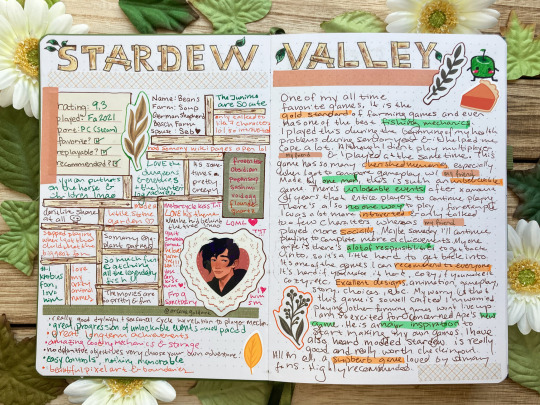

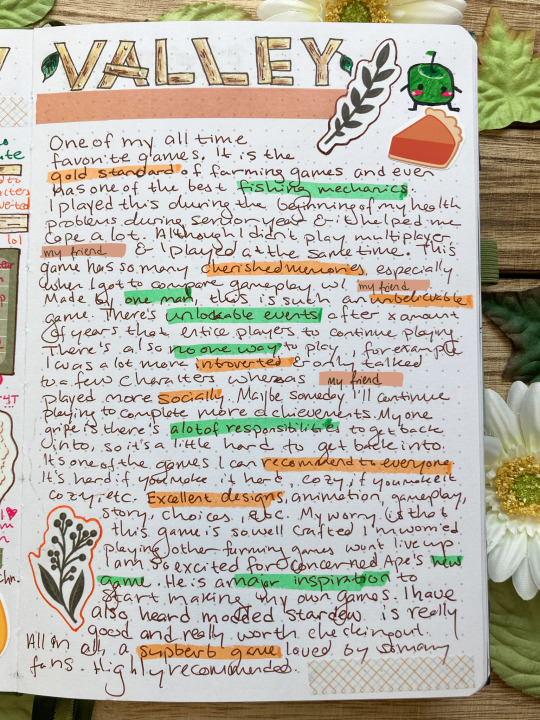
Stardew Valley!!! I love a lot about this spread but I wish I didn't use so many pen colors. This is another game I played before I even started journaling so I had to recall a lot of my older thoughts. Sebby's little corner might've been even bigger 😅 (Y'all might even guess where the name PumpkinSouppe came from, but it is also my favorite dish irl)
The Sebastian sticker is by ArcaneGoldArt! They have a whole collection of all the love interests.
Writing typed below!
Rating: 9.3 Played: Fa 2021 Port: PC (steam) Favorite? Y Replayable? Y Recommend? Y
Comments:
Name: Beans
Farm: Soup
German Shepherd
Beach Farm
Spouse: Seb <3
The Junimo are SO cute
only talked to like 7 characters lol I'm so introverted
had so many wiki pages open
LOVE the dungeons and enemies + the hunter log/achievements
It's sometimes pretty creepy
You can put hats on the horse and children lmao
don't like Shane at all (skull emoji)
stopped playing when I got the child, not the biggest fan [but I'm also against sacrifice]
#1 Krobus fan, love him
love my crazy animal names
made a little statue garden
so many eggplant parms
so much fun catching all the legendary fish!
the movies are so pretty and fun
The Sebastian corner: (DO NOT SAY ANYTHING)
(List of his favorite and liked gifts) Frozen tear, obsidian, pumpkin soup, sashimi, void egg, flounder, quartz
motorcycle kiss T^T
LOVE his theme
when he hid behind the tree lmao (I accidentally planted a tree right in front of where he would stand and I thought he would just disappear once a week and I could never find him)
quit smoking for me
he loves Jasmine tea!!!!!!!!!!!!!!!!!!!!!!!!!!!
you can kiss him <3!!!
Frog Sanctuary
Game Dev notes:
really good day/night + seasonal cycle with relation to player mechanics
great progression of unlockable events -- well paced
great long term achievements
amazing cooking mechanics and storage
no definitive objects, very choose your own adventure!
easy controls, nothing memorable
beautiful pixel art and boundaries
Summary:
One of my all time favorite games. It is the gold standard of farming games and even has one of the best fishing mechanics. I played this during the beginning of my health problem during senior year and it really helped me cope a lot. Although I didn't play multiplayer, my friend and I played at the same time. This game has so many cherished memories especially when I got to compare gameplay with my friend. Made by one man, this is such an unbelievable game. There's unlockable events after x amount of years that entice players to continue playing.; There's also no one way to play, for example I was a lot more introverted and only talked to a few characters whereas my friend played more socially. Maybe someday I'll continue playing to complete more achievements. My one gripe is there's a lot of responsibilities to get back into, so it's a little hard to get back into. It's one of the games I can recommend to everyone. It's hard if you makes it hard, cozy if you make it cozy, etc. Excellent designs, animation, gameplay, story, choices, etc. My worry is that this game is so well crafted I'm worried playing other farming games won't live up, I am so excited for ConcernedApe's new game. He is a major inspiration to start making my own games. I have also heard modded Stardew is really good and really worth checking out. All in all, a superb game loved by so many fans. Highly recommend.
60 notes
·
View notes
Text
Experience Hair-Raising Horror with FOR SALE: A First-Person Adventure

FOR SALE is a well thought-out first-person horror adventure game for both Linux and Windows PC. Thanks Collarpill for working their magic and bringing this creation to life. Which you can find on Steam with its 100% Positive reviews. If you’re into short, spine-chilling adventures that send shivers down your spine, FOR SALE might just be what you're looking for. This first-person horror quest delivers an eerie adventure, atmospheric experience that also grabs you right from the start. But it doesn’t let go until the credits roll. With a strong focus on exploration and unraveling secrets. This Linux game has all the creepy vibes you're due to expect from a haunted house visit. FOR SALE drops you into what seems like an ordinary house, but there’s nothing ordinary about it. You’ll interact with objects, dig through furniture, and also uncover notes that hint at the unsettling story hidden beneath the surface. Your trusty digital camera will be your best friend. Which also helps you capture clues and maybe even things you wish you hadn’t seen.
FOR SALE - Gameplay Trailer
youtube
What sets FOR SALE> apart is its nostalgic feel. If you miss the PSX and PS2 era with its handcrafted assets and slightly grainy visuals, this release nails that vibe. It’s like stepping back into the title you grew up with — just with a more terrifying twist. And let’s not forget the hidden collectibles, achievements, and multiple endings that add some nice replayability. Can you discover everything lurking in the shadows? Challenge accepted! While it’s a short experience, it has a design that pulls you in completely. One sitting is all it takes to immerse yourself in the chilling world of FOR SALE. Pro tip: grab your headphones, crank up the volume, and let the sound effects do their thing. Now, here’s a heads-up: some of the in-game assets, like the artwork in paintings or magazines, and a few sound effects, were generated using AI. While it doesn’t take away from the handcrafted atmosphere, but it’s worth noting. Also, fair warning — this title deals with mature themes like accidents, death, and psychological horror. So, if that’s not your thing, you’ve been warned. In short, FOR SALE first-person horror adventure is perfect for fans who like exploration, a good scare, and a nostalgic blast from the past. It’s spooky, immersive, and will leave you double-checking your own house before bed. Are you brave enough to uncover its secrets? Find it on Steam with the price of $4.79 USD / £3.99 / 4,71€ with the 20% discount. Along with support for Linux and Windows PC.
0 notes
Text
Okay, I finished Hiveswap 2 in... basically all one go. I will definitely have to do multiple replays to get all the Steam achievements, but that can wait until I do all my actual work and projects. Thoughts and major spoilers below.
Well Hiveswap 2 was certainly interesting! I can see why it took so long to make, and why Friendisms had to come first. That game certainly gives some more background lore to certain situations, though it also kind of… gave me certain character expectations that I feel were left unfulfilled. Like… given it is Alternia, and Doc Scratch admitted to messing around with everyone involved via his whatever-it-was making people more open to befriending the reader, I guess I’m not entirely surprised how certain situations ended up? Just… severely disappointed.
As far as gameplay goes, I think that the item management system was a little better than in part one, and it was cool that you actually got to switch between playing as Joey and playing as Xefros, and that they each had different commentary when you clicked on things. There is also a replayability factor, which is nice. The music was also really cool, especially how you could tell that the same melody was being used in every train car, just changed up a little to better fit the “theme” of the castes present in the cars. And that even held true when it got a lot darker/more depressing during the final quest! I’m also extremely glad that there was a functional hint system, because there were times when I really, really needed it.
But the bee minigame came pretty much out of nowhere, and the formatting for the directions was horrendous because it gave them to you after the game already started. Not in a tutorial fashion, either! Which meant that I couldn’t really read or understand what was actually going on until I’d failed the game two or three times, making the whole thing really tedious. Also… I’m kind of annoyed at how little actually got carried over when you use the “import Act 1 data” function? Like… inventory was the same, and maybe there were some things I missed, but it didn’t keep the name I gave Dammek’s lusus! It didn’t even use the default name for that option, either, or even throw in a line about Xefros telling you what it’s actual name was at some point while you were fleeing, which would at least explain the discrepancy.
Then there was the jade and teal car… and oh boy do I have a lot of complaints against that car. It’s honestly the one I had the most problems with, from both a gameplay and story perspective. For one thing, it dragged on way, way too long—especially for a middle section of the game. It would have worked a lot better as an endgame thing, I think, just in terms of the way games and stories are supposed to ramp up the action as you play, so things get progressively harder as you go. While there was some nice foreshadowing of how depraved the purple caste really is during that section… like the early game foreshadowing for it, it only really works effectively if you know the source material.
I mean. I guess Xefros’ discomfort in general works and gives it more of a wham/gut-punch for those who don’t know the source ahead of time, but… still.
Anyways, the length isn’t my only complaint with that section. The story was very interesting, I’ll admit, but the execution was not very good, especially when it came to the evidence. Now, I know this is apparently a common complaint with Phoenix Wright games, which that section is based on—that there is a specific order and place you need to use specific pieces of evidence, even when logic dictates that there is a far simpler solution to the problem. Like… at one point you need to come up with a motive for Tegiri to be hanging out by the Jade lockers. Considering that the entire trial has to do with the theft of a “forbidden book on rainbow drinkers,” this is something you find out during the evidence collection phase before the trial even begins, and another piece of evidence collected clearly states (or at least implies extremely heavily) that Tegiri is into rainbow drinker stuff, one would think that piece of evidence would be enough for a motive, right? Wrong. Instead, you have to use a broken action figure… and then you STILL use the other piece of evidence to show that he’s into weird romance stuff and would have been interested in reading the book! And that’s not the only time stuff like that happens!
Not to mention the section in the middle where the trial takes recess. The dialogue implies that what’s happening is you’re getting the chance to collect more evidence and statements… but, no, what’s actually happening is that you’re supposed to be taking this time to accuse other people of actually being the culprit by combining two pieces of evidence. The problem is, it doesn’t tell you this is what’s happening, give you any warning that you won’t be able to talk to the people you’re accusing again if you combine the wrong evidence, or let you use any selection screen aside from the evidence ones when it would be extremely helpful to be able to check on the timeline or suspect section again in order to get a refresher on where everyone was. And one of the pieces of evidence is a diary—but once you have it in your possession, you can’t check the relevant entry again! It only says who the diary belongs to and that some of it is censored. And since there is reason to believe that someone else messed with the diary to implicate the owner, it would be very helpful to actually get to explore that further in depth!
I really do hope that this is a case where there are multiple different endings, since the way it left off on my playthrough left an extremely bitter taste in my mouth, especially in regards to Tyzias’s character, who I actually really, really liked in Friendisms! But here… I got the “Scapegoat” achievement (which is why I’m hoping that there are other ways to complete this section), with the end result being that even though we got our client declared innocent, we also got an innocent (or at least, one heavily implied to be innocent afterwards) person declared guilty—in part because our co-counsel did not inform us of the fact that she witnessed evidence being tampered with and, in fact, knew who the true culprit was all along. And while her “Experiment” was deemed a success—and, I suppose, was technically successful within the set rules and did actually follow the whole “innocent until proven guilty” thing—it just highlighted that legislacerators still don’t actually care about justice. She could have, at any point, chimed in about what she saw, but was more interested in “keeping the peace” afterwards than actually getting the true culprit. And, yeah, baby steps and all, but…
I suppose thematically it does work well considering what happens at the end of the game when reaching the purple car, but…
I just thought better of Tyzias, is all. Friendisms implied that she was a real revolutionary for change, and, yes, I know that this wouldn’t be obvious to someone who didn’t play that game and some allowances must be made for that, but… even so, it just seems really out of character, and I don’t think it can all be blamed on forgetting lessons they learned while hanging out with the Reader/those things not actually happening in this continuity, for whatever reason (though, given how Fozzer was acting, and the fact that Chixie brings up the whole “Mask” persona, I’m pretty sure that we can assume they all remember some things that happened… just in a way that’s vague enough that those who played Friendisms can catch the references while those who didn’t won’t be lost on what’s going on)
…And, in hindsight, the whole thing was probably unnecessary to begin with since the book actually got found before the idea off a trial even came up??? I mean, part of that is because Marvus suddenly wandered in and seemed very interesting in holding one, and they didn’t want to upset him, but… yeah, it’s definitely a case of “this all could have been avoided,” especially since the book is apparently only forbidden for the jades to read. But I’m willing to give that one a pass, since trolls are weird and there were various circumstances escalating the situation.
I still think that Tagora had something to do with it, given what we know about his infatuation with Rainbow Drinkers from Friendisms… but that never actually came up in the game? I see where there may have been an opportunity for it, but it wasn’t a very clear-cut one and, at least the direction my playthrough went—would have required the player to actually have done his route in Friendisms.
(EDIT: Apparently there are some different ways to do this trial, according to some things already up on Steam, but they are dependent on some very early choices in the game--which would presumably affect some other choices in later games, and which means that i’m going to have to do many different playthroughs if i want to see everything available--and it still isn’t likely to remove the taint on my feelings towards Tyzias. After all, I’ll know that such capabilities for ruthlessness remain in her character, whether or not they’re actively showing.)
Also, hero-mode Xefros looks a lot older than I thought he was. And apparently joey is old enough to at least be a Freshman in high school??? I thought she was still in middle school!
As for other characters… some I felt were still in-character, some weren’t. Like… for what little we actually saw of Karako’s personality, considering he doesn’t really talk, I thought he was fine… despite being extremely surprised he was actually on the train at all considering his youth and, well, what little personality we saw indicating that he doesn’t really do “civilization” much. But the twins… while they were spot-on amongst themselves (resulting in an extremely chilling and heartbreakingly well-done scene near the ending), they seemed a lot more vicious in regards to their interactions with others. Wanshi apparently developed a real cruel streak in this game, and, ironically, Tirona was actually a whole lot nicer and not actually a suspect of that trial, despite being put on the stand as a witness.
I was also a bit disappointed that there weren’t more of those clever fight scenes we had from Act 1, where there was puzzle solving going on mid-fight—there were only two of them, one being so forgettable that I pretty much only remembered it existed just this second, and only the last one was really clever. There was at least one, maybe two other points where it would have been really cool/creative if Joey could have solved things with dance in a battling format… but her use of her dancing shoes was only plot important at two points in the game—and that first point wasn’t even her doing actual dancing, but, rather, as a buildup for the bee minigame. And then she never even got to use her “bee dance” skills again. At least Xefros finally got to use his bat—but, again, it was only once where it was actually a useful tool. He did get to use psionics more, though.
And there was a plot point with Skylla that was pretty much completely dropped? I mean… they did bring it up as something that was still unsolved right at the end, but… well, hopefully this just means that they’ll actually solve it for real in Act 3, because otherwise there was a perfectly good opportunity for a solution that Joey had in hand, but which didn’t get utilized. The issue is that Skylla’s lusus is apparently sick. One would think that this means that, assuming you carried over from part 1 (and I would assume even if you didn’t because it looks like a lot of the problems would be game-breakingly unsolvable if you didn’t have certain items you would have picked up through a playthrough of part 1. I guess that’s something to test for next time), this would require you to use the bestiary and vet kit, right? Wrong: I tried that and nothing happened. Apparently, the solution is that you promise Skylla you’ll look for medicine further down, and use that as a reason that Marsti should move away from the door so that you can pass by. But there’s never actually an option for you to look for the medication.
…Now that I think about it, though, this would be the prime opportunity for some inadvertent (or intentional, as the case may be) foreshadowing from Act 1. Two opportunities, even, with one being far more obvious than the other. One could be that Joey makes some commentary about knowing exactly what to do, having seen a similar problem in her own “lusus”—her pet dog back home. The other could be that Ladyy isn’t actually sick, but is instead pregnant and having little lusus puppies—which would be a callback to that Puppy Surprise doll from Act 1 where Joey hid her keys.
Still. I don’t like the fact that it never got solved in this part. Also that Vikare didn’t really get to do much (despite how annoying and confusing I myself find him) and that we didn’t get to see Fozzer again on the train even though we got to see several others on the train who we first saw at the station.
I’m also wondering what’s going to happen in part 4? Obviously part 3 is going to be either the party or further attempts to reach the party (and the suddenness of what happened with the ending does lend some more seriousness to the whole “you only have eleven days before everything gets destroyed thing), but… I’d assumed going in that two parts would be dedicated to Joey’s story, and two to Dammek’s, but apparently that’s not the case? If Joey really does get four parts to herself… then what the heck is Dammek’s story going to entail? I mean… those monsters, obviously, and whoever Jude’s “friends” are, but… I don’t know. I feel like it’s going to be hard to top this.
As far as lore goes… apparently the maturation trials are not the same thing as the exile, since Zebruh mentions already having gone through his, yet he is still on Alternia for what is implied to be… at least two sweeps, I think it was? I think he said he went through them at seven, and Chahut is approaching 9 or ten and mentions being only a perigee away from leaving. So that’s interesting. I guess the maturation trials are the equivalent of a career aptitude test or something?
It does make me wonder what happens with the Jades, though. Unless there are more mothergrubs on other planets, what do they even do when they’re off world, since apparently they are specifically tested when they are a lot younger to see who actually is assigned to the caverns vs. just living outside with everyone else. I guess maybe they just get jobs that are slightly more prestigious than olives, but still under teals? That would at least make sense for the ones who weren’t assigned to work in the caverns. Though it does make me wonder about Kanaya a little bit—had there been no game involved, would she still be considered “special” like the jades from Hiveswap given what her lusus was, except that because of said lusus she had to live outside of the caverns? It was, after all, implied that virgin mother grubs and their matriorbs were extremely rare.
Also, considering how full this train was, and the caste segregation going on, I’m wondering why the train from Sollux’s route in Pesterquest was so empty, and how he could apparently just get on any car he wanted. I mean—sure, he ended up in a car that only had an olive on it, but considering they were literally the only other passenger besides reader, that may have just been a coincidence. It can’t have been that there were separate waiting platforms for the different castes, either, since everyone was mingling together in Hiveswap before separating by car. Is it just that everyone was going to the party, but the train otherwise doesn’t get much use, or something like that? Or did it have more to do with whatever the ramifications were for Trizza’s defeat? …Or possibly the fact that the attack on the train at the end just made people still extremely wary about travelling by rail even sweeps after the fact?
There’s probably some more lore I can touch on, but… honestly, the trial section left me so upset that I can’t really put much of that together right now. I think I was going to say something about how the Jades would also be a good source of keeping culture alive between heiresses, since apparently they’re actually charged with doing so… but it’s hard to tell how much of that culture is just jade culture specifically vs. the rest of Alternia. Or even how much of it was actually serious, rather than a thinly veiled reason to let everyone indulge in things like tabloids, celebrity magazines, and rainbow drinker books.
Oh, yeah, and I’m pretty sure that Diemen at one point implied that his hot dog was actually made out of someone specific, though I’m not sure at this point whether that someone was his lusus, or if it was a troll. Either way, if that’s true, then it definitely explains why he is so protective of that specific hot dog.
EDIT: I remembered what the other bit of lore I wanted to discuss was. Well. I mean, it might not be considered “lore” as such, but... it’s interesting that of the two major rebellions we know of, both were headed by bronzebloods--that being the Summoner and Dammek. At least, I assume Dammek is the one heading the current rebellion. I wonder it it’s just a coincidence, or if there is something in bronzeblood nature that makes them more likely to lean towards these sorts of reactions? We know Dammek’s breed of lusus apparently favors strong leaders, and given the blood color would only be seeking out other bronzes (except perhaps when they hit the “my charge just died/got culled” stage and go looking for someone else to adopt, given what is happening with Joey), but presumably the Summoner had the same lusus type as Tavros. I dunno, it’s just interesting to think about.
Anyways... Overall I did really like the game! I loved the tone, despite how depressing it got at times, and Xefros’ and Joey’s developing relationship is amazing. I look forward to part 3. Hopefully it won’t take as long to come out.
7 notes
·
View notes
Text
Graveyard Keeper Review
Platform: Steam
Playtime: 73 hours
Game Stats: 484 graveyard points, 70 church points, 81 tavern points, 91 Gold, 15 or so zombies, +/- 2k red points, +/- 1500 green points, +/- 500 blue points, did not unlock all the technologies.
Mods used: Faster Craft, Increase Inventory, Infinite Energy, Inflation Mod, No Cooldown Teleport, Sprint
---
Okay, so I finished the Graveyard Keeper (discounted at 4 or 5 bucks), together with its two DLCs, Breaking Bad (free) and Stranger Sins (6 bucks). Overall for that price it’s pretty good.
Spoilers ahead, of course. Oh, and very long rant if you’re up for the read.
So it starts with you going to a store to pick up some groceries, then you look at your phone while crossing he street and it’s you love calling, and because you didn’t look both ways before steeping on the crosswalk, you die. And then you wake up as the next graveyard keeper.
Honestly, whoever the last one was did a poor job of keeping the graveyard, cos what the fuck are all these bad corpses doing buried here? JK. ANYWAYS.
First, we’re gonna talk about mechanics.
I loved the game. It’s much like Stardrew Valley in a sense that you’ve got pretty much the same thing going on, except that it’s much, much, much more stressful. You can’t just go forage things and then sell all of it expecting you’ll get money and then buy the thing that you need to accomplish this task.
Nope. It’s none of that. it’s goes so far as you have to make your own goddamn ink to write something. But then you’d have to go to the poultry to buy feathers to write with?? There’d been too many time’s I’d say ‘what the fuck’ every time I’d have to craft something to do something as mundane as fucking frying onion rings.
There’s a review on steam that perfectly summarizes what I feel about the game as a whole. It’s a review by Isackender they say:
“I love grinding games like Stardew Valley, Don't Starve or Forager. When you play them, you feel good completing a task because what you just achieved will help you to advance slowly towards your goal. And what's most important, these tasks are fair.
Graveyard Keeper fails miserably at doing this.
A lot of the tasks you're required to complete feel meaningless.
…
That feel of ‘I haven't done anything today’ is constant.”
And that’s true! Every time you go to bed or mediated for energy, it feels like, even though you’ve buried a body, planed some crops, chopped down some wood, crafted all these things, mined a crap ton of stone and marble for graveyard decorations, it’s never enough. You literally have no means of earning other than burying shit-rated bodies at the start, so that you can get money to buy crops that you need to sell in order to make more money. What’s more frustrating, is that if you sell too much of one thing to any NPC who’ll buy your shit, you won’t be able to sell that other 400 pieces of carrots you’ve harvested because they’ll have no money to buy more, and your crops will be of no value because there is too much of it. I mean that makes sense IRL, but god. I was stuck at two silver coins FOR WEEKS.
Though I think I might be comparing it too much to Harvest Moon or Stardew Valley, where everything you do gives you an idea of what you’re working towards: a great farm, with diverse produce, healthy animals, and a good income.
God you’d be crafting for WEEKS and you’d still not be able to earn anything.
I only finished it out of spite. I mean, I’m already here. I already wasted 40 hours on it why not just fucking go on with it? 40 hours! That’s 10 hours more than I work in a week these days.
You’re also confined to a day in a week to do everything you need to do. Many of the NPCs you need to interact with that has something to do with the main storyline are only available once a week. So if you forget what day it is, you’d have to wait for another week to move along whatever it is you want to move on with. I always forget this with Snake, the Astrologer, the Merchant, and Ms. Charm. It’s frustrating to have to trudge through another week and then maybe forget again that Ms. Charm is singing at The Dead Horse today. It’s mad.
And then there’s The Town. You spend MONTHS on earning enough money to get you a Town Pass, only for you to be struck down by lightning the moment you pass the gates. So what’s the point of building up hype and telling you that you need to get to Town, and gather all of these items for you to be able to craft the thing that will get you home? The Town literally does not exist. Which is also annoying because southwest of the Farmer, THERE’S A COAL VEIN THAT I NEED FOR THE FURNACE.
The literal amount of wood you need to advance in this game is insane. I mean I have zombies chopping wood for me but still.
Teleport stone needs way too much time to cooldown, hence, the mod. I hate walking at a glacial pace, hence, the mod. I was frustrated with the money, hence, the mod. It’s not a mod to make me earn faster, but a mod to let me sell as much as the buyer is selling their products. Shit amount inventory, hence, the mod. And I’m not wasting two days for something to craft in the furnace, hence, the mod.
I also hate that big pieces of wood don’t go in your inventory. It’s frustrating because what if you chopped down something on the other side of the map? You’d have to lug that shit one at a time back to your work yard? And then, when you’ve got too many items on the screen, like for example, just because you want to, you chopped down all the trees in your backyard, leaving behind, say, 50 pieces of log. The FPS will drop like a bitch. Seriously. I was at a constant 60fps at the start then by the end, when I’ve got my yard set up, together with the vineyard and my zombie farm, the game is always at a constant 25fps and it’s hurting my eyes. There was a time I left zombies mining at the quarry; the game dropped to 1fps every ten seconds! UGH. JLAKSDJAKSD
Okay. So. Mechanics aside, now on to the story. I mean, alright, it’s cute. I decided to finish the tavern first. The Stranger Sins DLC is where the story of the town comes from.
There’d been an old god and a new god.
I have a lot of questions. Keeper was split in two. Why and where did the old god send him? Why did the old god grant people immortality in exchange for destroying their faith in him? WHY DOES THE DONKEY TALK? I farmed hundreds of carrots for this asshole and he doesn’t even get a story?
Also, what the fuck is up with that shitty ending? I mean, that’s it? It just. Ends. Like that. you don’t go home—your Missus is transported to you and it ends. What the fuck? I wasted 73 hours for that shit?
There’s no replayability either. You finish it and that’s it. you go back to your save and you’re send back to the last time you saved it. It doesn’t even save after you open the portal so you could work on improving your graveyard or make more wine for your tavern.
It’s fun for a while. But if you might not finish it.
7 notes
·
View notes
Text
Pillars of Eternity - Definitive Edition: Impressions, Criticisms and Review
Published by Obsidian Entertainment. Original release date: March 26th, 2015. Definitive Edition release date: November 15th, 2015.
Price: $29.99 MSRP. Current Steam Sale: $7.49. Current Epic Games Sale: $9.99 (with coupon.)
This article has also been published on Blogger.com (Mirror Link)
12/23/20

Over the past week or so, as a part of the Epic Games Free Game of the Week promotion, I’ve picked up Pillars of Eternity - Definitive Edition for free and have been playing it on its Normal difficulty almost nonstop ever since. This being the second video game by Obsidian I have played (the first one being Outer Worlds--releasing four years after Pillars had its original release), I felt it appropriate to share some of my thoughts over the quality and experience of this game, comparisons I have made, and some other miscellaneous observations. It’s worth prefacing this with that I have not fully completed a run through this game and haven’t actually completed the game’s second act as of yet (more on this later)--however, I’ve put close to 70 hours into this, and while others have spent thousands of hours on this video game I feel I can write on this with some authority.
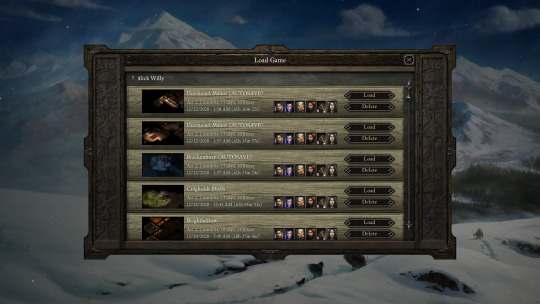
Starting with its strengths, Pillars of Eternity is engaging. There is a lot of content to delve into. Much of its characterization is convincing, and the voice acting that it does have is well-performed. Another YouTube channel that I watch, “Should You Play It,” estimated in their review that “25%-30% of the game is voiced,” which seems like an accurate assessment to me. Regarding its story writing, its overall plot and characters themselves are very reminiscent of a decent or good Dungeons and Dragons campaign. Some tropes can be expected, but overall the plot runs smoothly enough, and the characters themselves are generally rather fun to interact with, even in cases where they're not very original.
The game does suffer from a variety of flaws, many of which aren’t immediately apparent to the player and that bear mentioning. The talent pool that Obsidian recruited to do their voices is incredibly small. Half of my party, as it turns out, was voiced by Matthew Mercer--possibly the most distinguished voice actor of the bunch--with my main character (using the “sinister” voice effects), the story character Aloth, and the story character Eder all being voiced by him. Kana, a character that comes later on, is voiced by Patrick Seitz (famous for many different television, video game and anime roles) and also does a character at the beginning of the game (Sparfel), the voice for the commander of the Crucible Knights, and multiple other additional voices. To my own ears, Richard Epcar had to be the most frequently-appearing voice actor in the game, voicing the Caravan Master at the beginning, Raedric’s voice, the spirit of Od Nua (whom I haven’t encountered yet) and the forge master Dunstan in Defiance Bay, along with other additional voices.
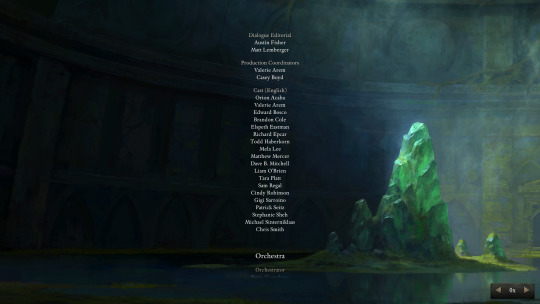
Sadly, Pillars of Eternity’s Credits page as well as the Full Cast and Crew IMDB Page only provide incomplete insight on who voiced which character within this game, and while some message boards exist on the subject I’ve not found a comprehensive resource over this topic (maybe I’ll attempt a full list for myself later on.) It’s a massive rabbit hole to go down nonetheless. The Outer Worlds handles this limitation as well, although that game’s execution of this I’d be inclined to say was a little more successful. Only 1% of Outer Worlds's entire production team were actually voice actors, which strikes me as interesting; the NoClip documentary series discusses details about this as well as how the writers had to plan questlines ahead of time to prevent characters with the same voice actor from interacting with each other, when possible. No definable moments of this happening in Outer Worlds come to mind off memory, although there were a couple of occurrences in Pillars (e.g. Kana and the Crucible Knight commander) where it wasn't avoided.
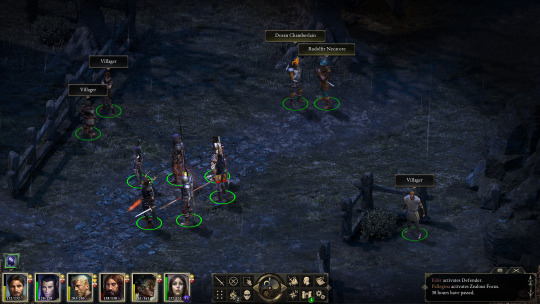
One of Pillars of Eternity’s major problems is interestingly a feature of its design--its Kickstarter rewards implementation. When you visit the first town, you are effectively bombarded with a number of uniquely-named NPC’s--and when you approach them, you get the opportunity to “look into their soul” or walk away. As a new player I was pretty befuddled by this, thinking that these were details I needed to memorize for some upcoming puzzle, when in actuality it wasn’t anything more than crowdsourced product-placement.

Some games can pull this off with success--LISA The Painful, for example, had a majority of its character names sponsored and selected by Kickstarter backers. As an RPG, this worked; you had a name on-screen detailing who it was that you were going to attack (on a black border above your characters), you kill them, and you move on. Other donor rewards involved creating a party member or a boss battle character, but these were done cautiously, and at least in my own experience, they didn’t hinder the game enough for me to discover that these were Kickstarter-donor characters on my own.
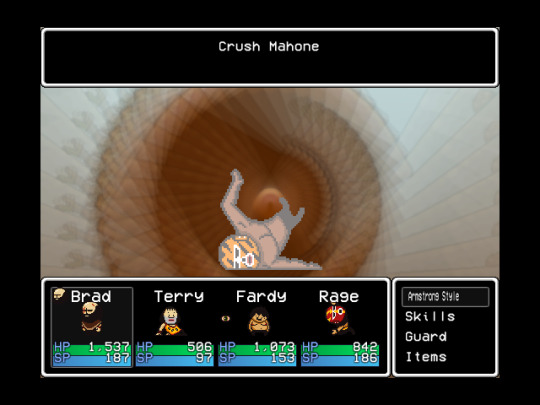
It’s the opposite case for Pillars. In many cases it’s special snowflake-ish. You’ll enter a bar and encounter 5 people named “commoner” and Archduke Franz “Quickfeet” Elfenhein, with a two-paragraph set of memories that mean frick-all to the actual experience. If you read all of these, you *might* encounter one or two funny ones, but what’s the point? You can expect that these were written before a finished product was released. It’s a dilapidated experience. Later in the game you’ll visit a house, with one of these pointless O.C.s effectively “standing guard” for no other purpose than to nick you town reputation points for trying to steal something.
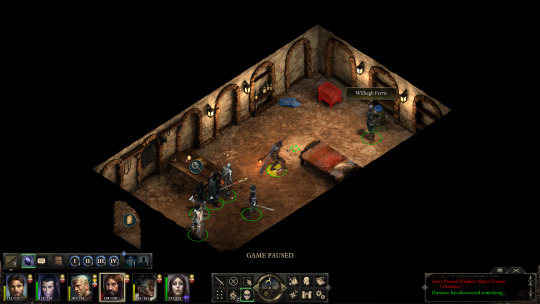
Outer Worlds includes a stealing mechanic as well but it was implemented more fairly. Your character didn’t have to dump a bunch of points into a nearly-useless Stealth skill--instead, it was dictated by NPC line-of-sight. Stealing in Outer Worlds, for the most part, is actually *fun*, in Pillars, it was worth me avoiding entirely.
This may as well serve as a segway into the leveling system--on which I don’t have much to say about it, other than (maybe not relative to other ISO-RPGs, or in comparison to, say, Dungeon and Dragons) that it’s a headache. The story characters that the game gives you access to all have unoptimized and relatively-mediocre starting-stats, so to use all of them (exclusively, without hiring an unvoiced “mercenary” NPC) some creative planning is needed. You’ll also effectively want to min-max your own character’s build to help compensate for inevitable party weaknesses--the game (similar to Outer Worlds) offers a releveling system should you level up the wrong stats, but anything set at character creation is basically unchangeable--which is when the greatest number of character traits needs to be decided. Wizards are good, a priest or two is required (otherwise your party is without a healer), Chanters are bad--but you wouldn’t know this unless you looked it up ahead of time, or unless you’ve played the game before.
And this description leads me to my strongest point--Pillars of Eternity has a habit of setting up unclear rules, punishing players for breaking them, and calling that “replayability.” To be clear, if these “unclear rules” were drawn across moral lines then it wouldn’t be an issue. Fallout: New Vegas has a few main factions that the player could side with and give control of the main world to; all but maybe one of these choices could be argued as potentially being the “best outcome.” Pillars of Eternity (and Outer Worlds to a similar extent) is lacking in a lot of this--*and* game mechanic-wise, the game punishes you for doing normal, explorative stuff and so often sets up inconceivably unwinnable scenarios where you have to be so deliberate about your actions and game mechanic options to actually achieve a (clear-cut) best outcome. Outer Worlds is better with this.

A small example; in the beginning of Pillars, your character encounters some rioting townspeople accosting the owner of a grain mill. If you go inside, the mill owner notes that he is fair in his dealings, although he prioritizes the best of his grain stores to townspeople who need it the most (like pregnant women)--this quest being strikingly similar to one in Outer Worlds’s beginning. If you pass a resolve check of 14, the mill owner will allow for his grain stores to be seized by the rioters. Only if you pass a intelligence check of 12 does he actually lower the prices--and you can postpone solving this quest for an absurd amount of time, waiting until you have the right items and buffs to pass that speech check.

Another example; when exploring the docks at Defiance Bay, your character can notice a shining purple light. If he/she interacts with the light, your character will encounter the memories of a dead child. Should you trigger this innocuous interaction, you will have locked yourself out of being able to talk with townspeople on the disappearance of this boy, which includes the boy’s father, who has since become an alcoholic at the local bar. If you had spoken with the mother first, and then him, and passed a speech check, the man would go back home--otherwise, he’s stuck at the bar forever.
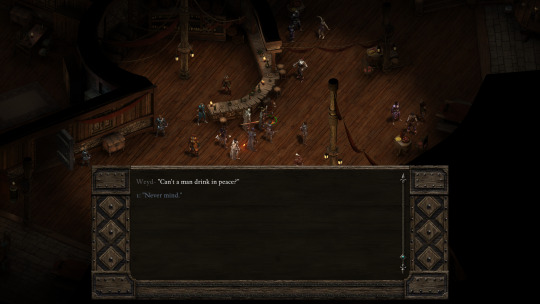
The worst example, *by far* of unfair, “gotcha!” game mechanics has to come from the quests within the game’s DLCs, The White March 1 and 2. Moderate spoilers ahead (warning to anyone concerned with those): you either have to outlaw the study of animancy, make certain dialog choices that lead to a companion becoming an evil crime boss, or lose out on a speech check at the end of DLC 2 when trying to teach mercy and compassion to a “god,” instead getting railroaded into one of two lesser outcomes, *OR* deliberately not finish the game’s second act, do all of the DLC stuff, and then come back if you want all three good endings.
Surely, however, it’s for “replayability.”
It’s punishing in the stupidest ways. Outer Worlds had a few negatives similar to this; you have two major factions that you can ally with, one being cartoonishly evil, and one quest exists where if you neglect to open up some unsuspecting dialog on a computer terminal (and instead delete it straight away) you permanently lock yourself out of a speech check and are then forced to genocide one (or both) of the other factions (or ignore it and get an even worse outcome.) Outer Worlds is metagameable in the sense that you can discover which decisions affect the ending slides ahead of time, and it encourages you to take advantage of its game mechanics a couple of times (particularly with how you can cheese an ending for a certain quest and with how you can cheese stealing a certain poster on Monarch that, by all accounts, an NPC should see you stealing) but certainly nothing to Pillars of Eternity’s scale--and it isn’t as demanding on the player’s time investment, either.
Another criticism--the amount of text present in both games fringes on ridiculous. To quote Philip J. Reed’s review on The Outer Worlds, “ Obsidian’s [writing] tends to be long, meandering, and packed with characters who will never use six words where a twelve-page monologue would suffice.” Pillars of Eternity is no exception to this claim; your character will frequently encounter lore books that most players will pick up and forget where they received them from (their placement usually being an inconvenience to immersion) and I as a player quickly had to learn to tune some things out--especially considering that I was already “metagaming”/looking up other quest analyses beforehand and had more-direct information about the characters on-hand.
A quirk in the dialog that’s consistent in both games is its style of integrating companions into your interactions; both games follow a formula of having an NPC talk to your character, followed up by a companion making some side remark that is hardly ever acknowledged by the NPC--as if your companion is whispering it to you (although the voice acting negates this), or as if it’s a theatrical aside, the companion characters doing a fourth-wall break to react to the events with you--and only you.

One aspect that Pillars of Eternity is stronger than Outer Worlds in, I would say, is in its combat scenarios. Early on in Pillars, the player is encouraged to storm a local leader (Lord Raedric)’s fort. The player has three options on doing this; climb up the side of the tower (using the grapling hook and some small skill checks) and fight through a small number of guards, go in through the main gates and fight most of the guards head-on, or sneak in through the sewer grates and fight monsters after using a strength check. Each approach has its own strengths and weaknesses, as this is early on enough that the loot you would acquire from fighting actually matters and each route can be fun in its own right.

Compare this with The Outer Worlds, where you have a similar fortress assault involving a sewer, a temporary disguise, or direct assault option, where the sewer entrance leads you straight to your objective, the combatants are innocent, non-soldier people (or robots), the disguise you would have falls off after every ten steps you take, and it’s late-game enough that attacking enemies won’t give you any worthwhile loot. Or compare it to the quest “The City and the Stars,” in which you can either stealth through a whole building, or kill the building’s guards and lose town reputation points... or pass a simple skill check where your character can acquire a permanent disguise and not set off any of the enemies whatsoever, allowing you free travel to loot and make it to your objective. Or again, compare it with the quest “Passage to Anywhere” where you as a player are either tricked into spending all of your money on opening up a shortcut, fighting and beating two overpowered enemies (which I did), or blitzing through an alternative route, outrunning all of the enemy characters and potentially bypassing a third of the game in the process (the easiest, by far, to do.)
Maybe these deficiencies are easier to see in hindsight, after a finished product exists, but these are negative aspects of game design.
The combat mechanics themselves are pretty fun. Sometimes the pathfinding glitches out (or A.I. will inhibit your characters from automatically attacking a new enemy), and the lack of a single button to change your entire party’s weapons is a small inconvenience, but for the most part it works well. The design choice of having this be a game where you repeatedly “pause” the game to issue new combat instructions (rather than feature a turn-based system) can be fatiguing over long play sessions, and Pillars being that style of game might be a dealbreaker to some players, but I generally enjoyed that feature.
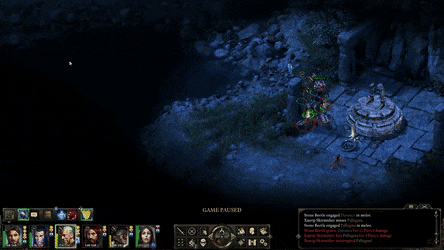
A final point on the writing--Obsidian is a little “woke.” There’s really no getting around this one. I’d like to revisit the idea of certain (reasonable) dialog choices not being included in Obsidian’s games, either out of laziness (e.g., in Pillars of Eternity, my character, a priest of Berath, encountered a small chapel to Berath... and all of the dialog choices amounted to “Who is Berath,” “I’ve never heard that title of Berath’s be used before,” even though other dialog checks take your background into account) or from lack of playtesting and feedback (e.g. in Outer Worlds, not having the option to transport a certain character to a different planet on this early quest’s third outcome) but certain decisions and design choices by the studio don’t have that excuse.
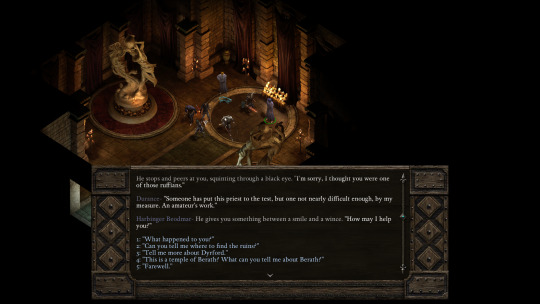
In Pillars, for example, the only way to get a good outcome on one quest and thus significantly raise your reputation in the town, is to lower the price of black market birth control. No moral qualms are raised and no ways for your character to roleplay against this are made available. Prostitutes also exist in Pillars of Eternity (although that feature remains partially broken), and the only way to get a (stackable, temporary) +2 enhancement on your resolve is for your player to solicit a male prostitute in the game. Outer Worlds also features a major quest, where you’re expected to assist one of your companions in getting into a lesbian relationship; again, no way to repel or address any disagreements or differences through your player character’s roleplaying are present. The mentality is like the equivalent of the show Arthur’s episode on gay marriage; “if we don’t address or allow representation for our opposition, it doesn’t exist.” It’s ironically closed-minded and annoying when the game that frames the weight of your moral decisions is so detectably and consistently biased.

Minor spoiler alert, but both games also feature a priest support-character that (at some point in the game) hates their god, and the character leading the not-evil main faction in Outer Worlds was directly inspired by Rick from Rick & Morty--if that speaks anything as to the mentality of this studio. Other choices, such as (in Pillars) winning reputation points by buying and freeing slaves as opposed to killing the slaver and freeing slaves, and winning reputation points for forgiving someone of manslaughter and allowing the person to keep his secret, also speak a little on Obsidian’s morality and inhibit player freedom in additional annoying ways.
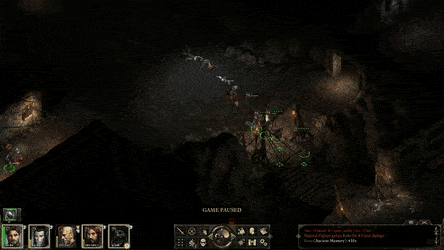
ALL that complaining aside... there is a lot to enjoy. It’s a big world to tap into, and it does have a sequel where you can import data from this game into that and have some of your major decisions be reflected in that game as well. It also features a stronghold (a Kickstarter stretch goal) that the player can manage--some meta knowledge of the game’s upcoming events and mechanics helps a lot in this, but it’s certainly a unique addition to this type of RPG and is genuinely a fun thing to work with. The combat mechanics are fun, although in many situations, it felt far easier to cheese the opponents’ pathing A.I. by luring a single enemy away, murdering him, and saving the game (note: both Pillars and Outer Worlds will likely leave you with a mess of save files after one playthrough), rinsing and repeating, and it would have been a welcomed feature had there been a button to change all party members’ weapons at once (which is helpful in that strategy, where you shoot a character, run away, and then beat on him/her/it as a group with swords) but the combat was still overall fun (albeit perhaps tiring and a monotonous after long hours of play.) The player economy is relatively punishing, with found items typically holding around an eighth of their sale value when you resell them, but this too is manageable (especially if you exploit a money glitch like the one from the first town.)
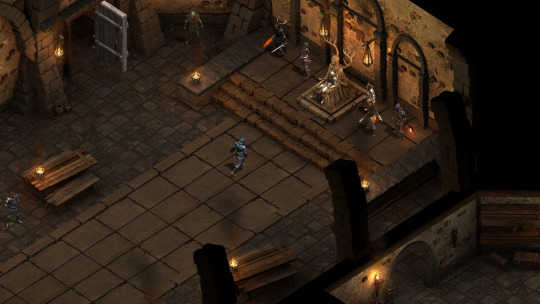
Obsidian can make a good game. It’s just disheartening to see that many of its flaws are systematic.
Ratings:
Pillars of Eternity - Definitive Edition: 7/10
The Outer Worlds: 8/10
Follow twitter.com/will_salsman for more content!
0 notes
Text
UnderMine gets a new mode called Othermine

Othermine is a brand new rogue mode in action game UnderMine for Linux, Mac and Windows PC. Thanks to developer Thorium. Who now levels up gameplay even further on Steam. UnderMine, the action adventure roguelike brimming with secrets. Thanks to developer Thorium Entertainment. So now they open the Othermine as part of the new v0.6.0 update on Steam Early Access. While the 1.0 version on Linux Mac and Windows PC will release later this year. Enjoyed by more than 100,000 players in early access. UnderMine follows peasants on a journey into the world below. While searching for fortune and freedom. These poor laborers delve deep into subterranean caverns to mine gold. And hopefully, acquire powerful relics, forge friendships, and discover secrets. Maybe even defeat a powerful bosses in the depths of the earth. So when one adventurer meets an untimely end. Then their belongings pass on to another. Hopefully that adventurer can make better use of them. Coming together in a fresh fusion of roguelikes, dungeon crawlers, and action games. Therefore, to unlock the Othermine, peasants must first conquer the four zones. So this means completing the main campaign. Hhacking and throwing their trusty pickaxes to mine for gold. Also, free promising allies trapped underground. And almost certainly survive the dangers of the mine. Gold earned during runs can get you permanent upgrades. The Othermine is new late game content. This introduces real roguelike design and endless replayability. Due to UnderMine’s blend of progress and procedural generation. After reaching the end of the fourth zone. Providing the Gatekeeper with a Nether. Peasants can enter the Othermine. With no gold and only base stats. Peasants must rely on a randomized assortment of upgrades. Along with relics, curses, blessings, and familiars to take on the challenge.
UnderMine 0.6.0 - Othermine Update
youtube
Othermine runs urges peasants to rethink how they get and use items. So you can rely on permanent upgrades. You will also need to adapt to the random drops. Veterans can earn Othermine Crowns for win streaks in the new zone. Unlocking three new familiars and seven new achievements. Seek greater challenge with the curse granting Siegfried's Aegis. The v0.6.0 update adds replayability to UnderMine’s campaign. Coming with two improvements for peasants of all skill levels. The Explorer’s Boots boost speed up by up to 40% out of combat. To also help streamline navigating the mines. A new magic mirror in Arkanos’ library randomizes peasants’ gender. Including thier color scheme, and name. You know, for those in need of a new look. UnderMine version 0.6.0 with Othermine is available now. That is if you don't already own the game on Steam Early Access. The game features support for English, French, German, and Spanish (Latin America). Including Brazilian Portuguese, Simplified Chinese, Japanese, and Korean. Not mention Russian language options. The version 1.0 Linux, Mac and Windows PC release. This is planned for a 2020 launch. For more information, please visit UnderMine’s official website, check out the game on Twitter and Instagram, join the official Discord server, and follow Thorium on YouTube and Twitch.
0 notes